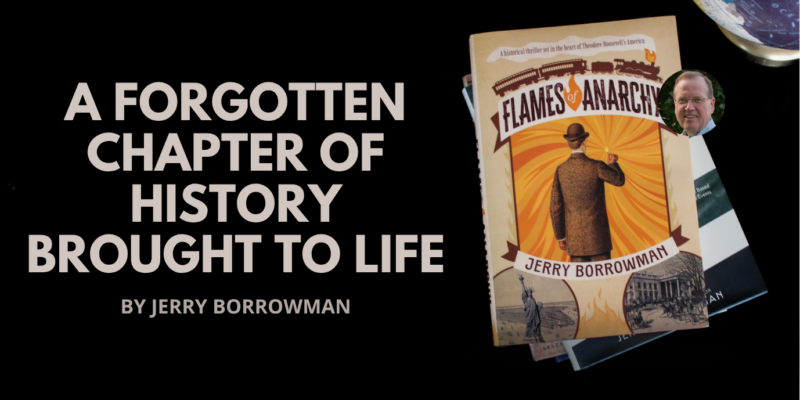
by Jerry Borrowman, author of Flames of Anarchy
Since my first book was published in 1989, I’ve focused primarily on historical biography and fiction related to World War I and World War II. That first book, Three Against Hitler, was written with Rudi Wobbe, who lived the experience. It has been a phenomenon—still in print thirty-six years later—because Rudi’s firsthand account of growing up in Nazi Germany and joining his teenage friend Helmuth Hübener in a resistance effort against the Nazis continues to inspire readers today. Their story is the basis for a number of movies, including one currently in production by Angel Studios. It was such a privilege to help Rudi tell his remarkable story and to pay tribute to Helmuth Hübener—the youngest person executed by the Nazi government.
In the years since, I’ve had another twenty-one books published, for which I am grateful. I love hearing from readers and learning how the various stories affect them and their understanding of world history.
But now—in 2025—I’ve written a book in a new genre, and I’m thrilled by the response from readers. Flames of Anarchy is a political thriller set in 1910 and features a very clever, very wealthy protagonist in Senator Jason Ellis, who built a fortune on Wall Street and went on to become the senior senator from New York. A close friend of President Theodore Roosevelt, his role as Chair of the Senate Foreign Relations Committee puts him in the crosshairs of anarchists who wish to disrupt governments worldwide.
Most people today are unaware of the impact of anarchists—the 1910 term for terrorists. Here’s an excerpt from the foreword to Flames of Anarchy that you may find interesting:
The anarchist Leon Czolgosz shot U.S. President William McKinley on September 6, 1901, in Buffalo, New York. The president died of gangrene from the bullet wound on September 14, and his vice president, Theodore Roosevelt, ascended to the presidency. Shortly after becoming president, Roosevelt declared that terrorism was a “crime against the human race.”
Anarchists and other revolutionaries also used bombs and bullets to target heads of state, beginning with Tsar Alexander II of Russia and killing the French president, the prime minister of Spain, the empress of Austria, and the king of Italy from 1881 through 1900. Seven attempts were made on the life of England’s Queen Victoria and one on her eldest son, Albert, who later became King Edward VII.
The most serious act of terror among all of these, of course, was the murder of Austrian Archduke Franz Ferdinand at the hands of anarchist Gavrilo Princip in the small Austro-Hungarian town of Sarajevo (now part of Bosnia and Herzegovina) on June 28, 1914, precipitating the First World War.
These attacks were often motivated by labor interests who felt the world unfairly favored the aristocratic and wealthy at the expense of the commoners who created their wealth. Their goal was to redistribute political and economic power by destroying the governments that they believed protected the unworthy ruling classes.
Featured in this book are a number of fascinating historical figures whose lives were affected by the anarchists, including President Theodore Roosevelt and his wife, Edith; Prince George (later King George V) and Princess Mary of Wales; and Kaiser Wilhelm II of Germany, who was also the subject of multiple assassination attempts. These historical figures interact with fictional characters to tell the story.
The primary fictional characters are Senator Jason Ellis of New York and his wife, Patricia; Pinkerton detective Andy Pettit; Angel Casimer, an idealistic and violent young anarchist; and Big Jim Fitzsimmons, a union organizer who directs Angel Casimer.
Taking a broad sweep of history, the book ranges from New York City, Washington D.C., and Chicago to London, Berlin, and St. Petersburg. All dialogue is a product of my imagination, although I’ve studied the historical characters to imitate their personal speaking styles as authentically as possible. I hope you enjoy the story.
1908 was also the year the Federal Bureau of Investigation was authorized, giving the federal government domestic police powers to oppose the anarchists. The debates of those days about the cost to privacy and individual liberty that might result from this new national exercise of power sound remarkably similar to the debates that rage today over the proper role of national security agencies in the first decades of the twenty-first century. Perhaps it’s fair to say that technology and times change, but people remain the same.
Flames of Anarchy comes out the first week of June 2025, and I hope you enjoy reading it. I’m already hard at work on a sequel set in the Panama Canal Zone during construction—two years after the events of 1910. I love researching history and turning it into stories that resonate with readers.
NEW! Flames of Anarchy: In the heart of Theodore Roosevelt’s America, a storm of anarchy threatens the nation, leading to a gripping tale of betrayal, fear, and the birth of the FBI.


Jerry Borrowman is an award-winning author of historical fiction and nonfiction. He has written about World Wars I and II, the Great Depression, and the Vietnam War, and about how four feet of plywood saved the Grand Canyon. He is the recipient of the George Washington National Medal from the Freedoms Foundation at Valley Forge. Jerry and his wife, Marcella, raised four children and live in the Rocky Mountains. Please feel free to reach out to me with any questions through my website: www.jerryborrowman.com.